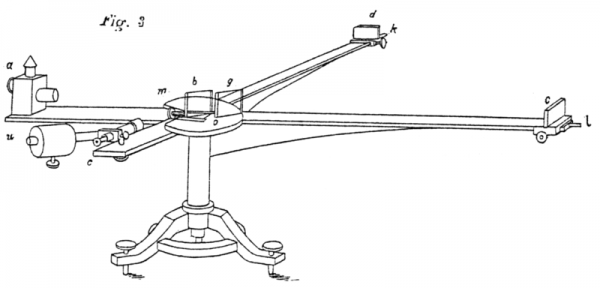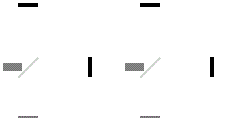“The conclusions, the bizarre conclusions, emerge as though with the greatest of ease: the reasoning is unbreakable. It looks as though he had reached the conclusions by pure thought, unaided, without listening to the opinions of others. To a surprisingly large extent, that is precisely what he had done.” -C.P. Snow, on Einstein’s 1905 work
In 1887, two scientists set out to measure how the speed of light changed with the Earth’s motion. What they didn’t find wound up changing the world.
Today's Ask Ethan is all about the most famous failed experiment in the history of science: the Michelson-Morley experiment. If ever you were curious how we detected that there was no such thing as the luminiferous aether -- and what problem Einstein's special relativity actually solved -- this is one for you!
Go and read the whole thing here.



We need to quit referring to experiments with negative results as 'failed'. Only when no usable results are obtained (swamped by noise, equipment failure [e.g., a loose cable = superluminal neutrinos], etc.) has an experiment truly failed. Even then, the details of the failure can help the next experimenter make it work.
On a different note, for people thinking the idea of a 'luminiferous aether ' sounds daft -- the Higgs field sounded just as strange (and for many of the same reasons) -- only this time experiments supported the new theory instead of disproving it.
There is an old joke from my beginning grad days in statistics
A young member of the French foreign legion was captured and thrown into a cell at an oasis in the middle of the desert. There was an old, bearded, emaciated prisoner in the same cell.
The young soldier, after regaining enough strength to walk, asked the other man how long he'd been held prisoner: "Thirty years" was the only response. Immediately the youngster knew he had to escape while he was still reasonably healthy. Five days later he was able to overpower a guard and get out.
A week later the cell door opened and the legionnaire was roughly deposited back into the cell. He was badly sunburned, his lips were swollen and cracked, and he had been beaten. Over the next few days the old prisoner nursed him back to health. Finally the youngster began relating what had happened, ending with: "I was blindfolded when they brought me here. I didn't know where we were: there's desert all around and no water or shade. I almost died. There is no escape."
The old prisoner replied "I know. Exactly the same thing happened to me when I was first brought here."
The young soldier was furious and demanded to know why he hadn't been told this. The old man simply shrugged his shoulders and said
"Who reports negative results?"
That diffraction animation looks a little odd, with lots of power going 'up' and 'down' and not so much in the forward direction.
A "failed" experiment is one in which the hypothesis is not supported to the predetermined level of significance by the data applied in the way the experiment specified before it was run. There are no "other results." The rest of the stuff is what we used to laughingly refer to as changes in the subjective probability in the mind of the experimenter. Though terribly seductive, changing the focus of the experiment due to "interesting" or otherwise statistically significant findings negates the scientific method.
Michaelson-Morley didn't fail -- it proved, quite conclusively, that Galileo was wrong: the Earth does not move.
Michelson-Morley is not grant fundable. Their mercury pool requires tens of $millions of exact inventory verification, containment, spill countervention, and employee safety.
40 years of quantum gravitation, SUSY, and dark matter evade testing. Exact boson photon vacuum symmetries applied to fermionic matter (quarks, hadrons) belch unending parity violations, symmetry breakings, chiral anomalies, Chern-Simons repair of Einstein-Hilbert action. Observed vacuum is trace chiral anisotropic toward matter. Noether's theorems couple exact vacuum isotropy to angular momentum conservation. Noetherian leakage is MoND's Milgrom acceleration (arXiv:1310.4009, 0906.0668). Dark matter is a curve-fit. End it.
Opposite shoes embed within a vacuum left foot with different energies. They locally vacuum free fall along non-identical minimum action trajectories - Equivalence Principle violation. Single crystal test masses in enantiomorphic space groups as a geometric Eötvös experiment will Michelson-Morley physics. Twice 20 grams of alpha-quartz, left-handed versus right-handed, oppose 6.68×10^22 pairs of opposite shoes (pairs of 9-atom enantiomorphic unit cells). DO IT.
I don't understand the illustration. If there is an aether, and the apparatus is moving through it from left to right, then the the aether impedes the blue dot as it moves left to right, but aids the blue dot by the same amount as it travels the same distance from right to left. So, you would expect no net difference in the time the dots reach the detector (but you would expect the red and blue dots to hit the mirror at different times).
JohnE,
A fun and simple physics problem is to calculate the amount of time it takes to make a round trip between two points with a constant current (or medium-flow) between them. When I teach college physics, one of the first such problems we always solve is for an airplane flying between two points with no wind and with a constant wind (headwind one way/tailwind the other) for the round-trip.
In all cases, you find that time is minimized for the "no wind" case, and rises the larger the magnitude of the medium flow is. The amount of time the "headwind" adds is always greater than the time saved by the "tailwind," or its analogue.
To all those who object to callling the MM experiment a failure, it actually was a failure, at least in terms of what it was meant to measure. The intent of the MM experiment was to measure the speed at which the earth travels through the aether. Obviously, Einstein used the result of this experiment (along with a proper interpretation of Maxwell's equations) to come to the conclusion that the speed of light is the same in all reference frames. This led to all the effects of special relativity. From that perspective, the MM experiment was certainly not a failure, but in terms of its original intent it was. It failed to provide a measurment of the speed of the earth through the aether.
I believe nothing should be labeled as a failure. Especially, in science that is. If a creation or experiment is not successful it can be improved or fixed to later become a successful operation. Just because there are no actual results recorded it does not mean it is a failure. Some creations are suppose to measure something in particular or are expected to get specific results. However, if something does not get the expected results I do not feel it should be called a failure. Everyone has their own ideas and can put their opinions or ideas together to create a final product. Nothing is going to be 100% successful its first try however, we should all take this into consideration when we are creating our own experiments or creations. I believe this creation has a good start and a good intention it just needs to be improved to get the specific results that it was intended to.